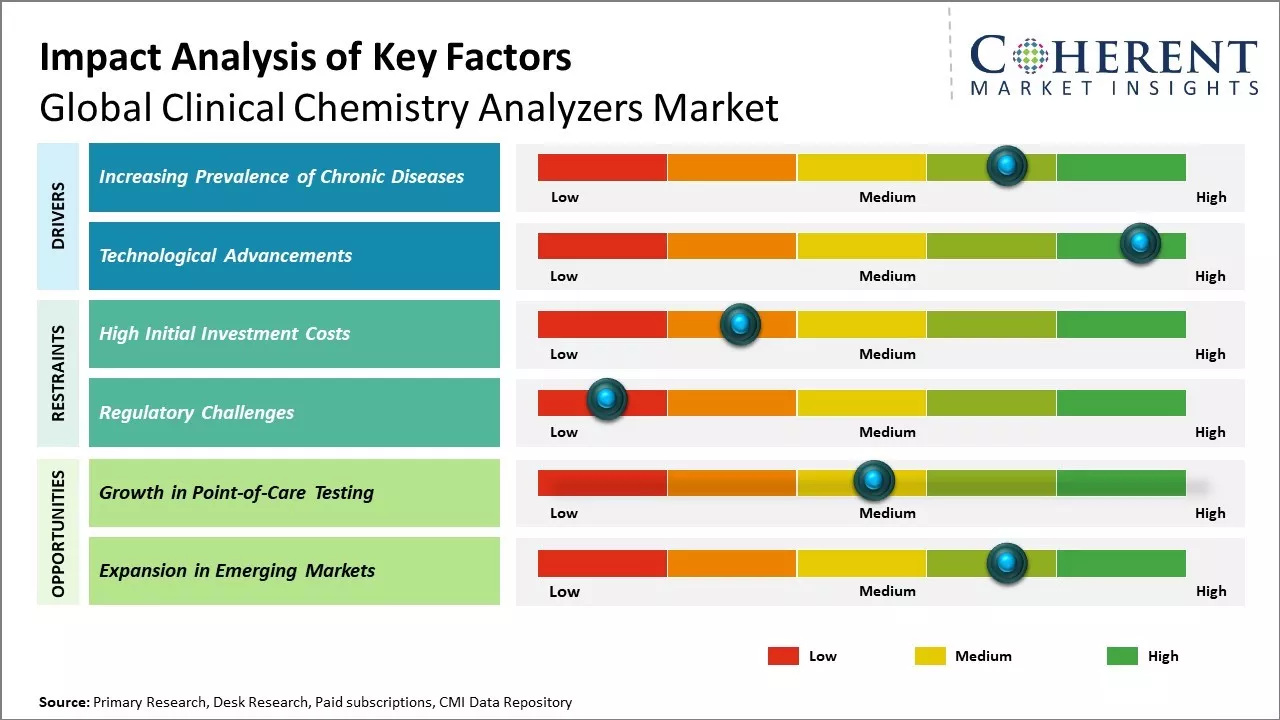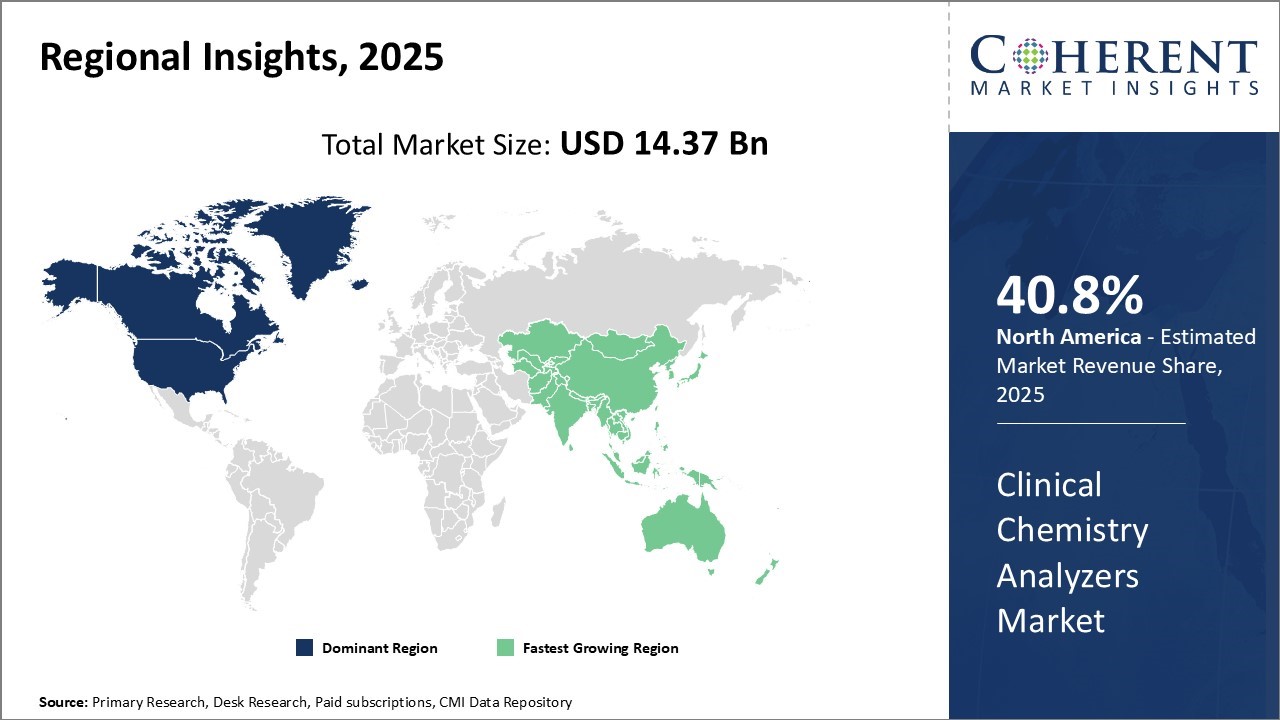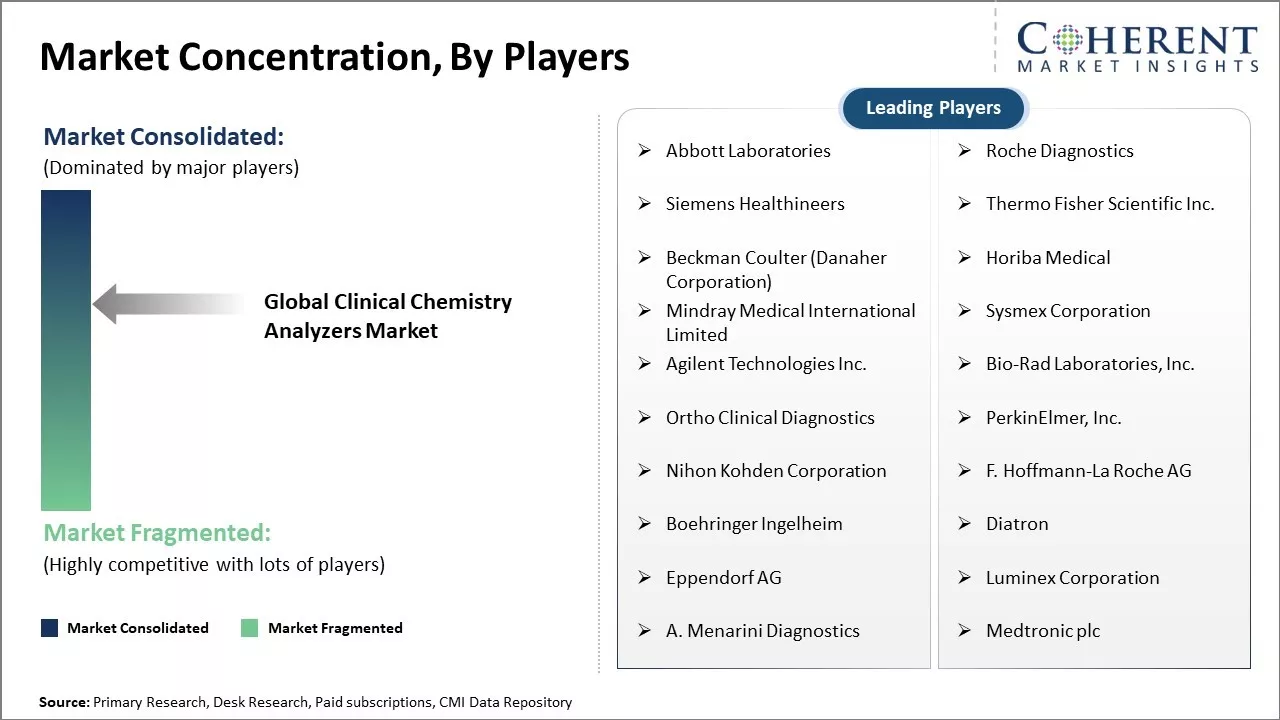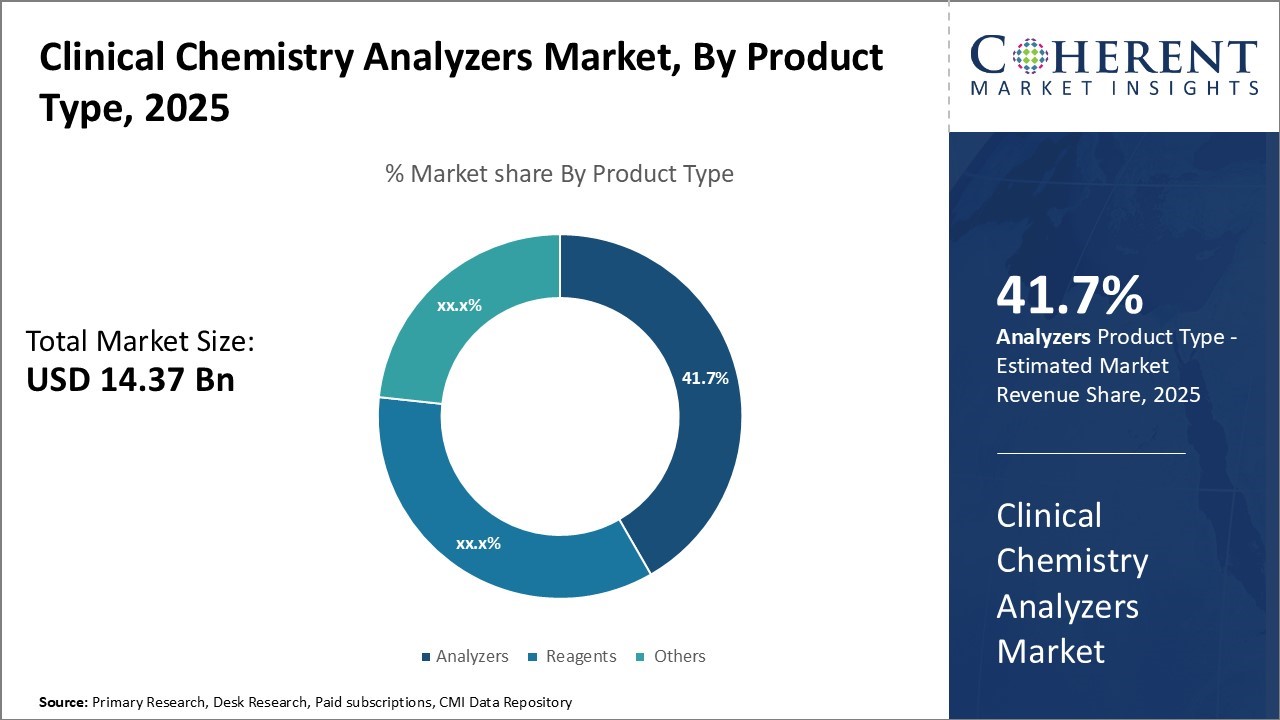Clinical Chemistry Analyzers Market Size and Forecast – 2025 to 2032
Global clinical chemistry analyzers market is estimated to be valued at USD 14.37 Bn in 2025 and is expected to reach USD 18.93 Bn by 2032, exhibiting a compound annual growth rate (CAGR) of 4.0% from 2025 to 2032.
Key Takeaways
- By Product Type, Analyzers segment is estimated to contribute the highest market share of 41. 7%in 2025, owing to continuous technological advancements.
- By Types of Test, Liver panels segment is estimated to contribute the highest market share of 42. 8%in 2025 owing to its increased incidence of liver conditions.
- By End-User, Hospital segment is estimated to contribute the highest market share of 41. 6%in 2025, due to growing in-house diagnostic capacities of hospitals.
- By Region, North America acquired the prominent market share of 40.8% in 2025 on account of high prevalence of chronic diseases & aging population.

To learn more about this report, Download Free Sample
Market Overview
Global clinical chemistry analyzers market growth is driven by rising prevalence of chronic and lifestyle diseases globally. Furthermore, growing elderly population susceptible to various health issues can also boost sales. However, high cost of advanced analyzers may limit adoption in price sensitive developing regions. Increasing healthcare spending can offset this challenge in the future.
Current Events and their Impact on the Clinical Chemistry Analyzers Market
|
Current Events |
Description and its impact |
|
Geopolitical and Regulatory Developments |
|
|
Technological Advancements and Digital Integration |
|
|
Macroeconomic and Healthcare Spending Trends |
|
Uncover macros and micros vetted on 75+ parameters: Get instant access to report
End-user Feedback and Unmet Needs in the Clinical Chemistry Analyzers Market
- Need for Greater Automation & Integration: End-users seek more fully automated systems that seamlessly integrate with Laboratory Information Systems (LIS) to reduce manual errors, improve workflow efficiency, and speed up turnaround times, especially in high-volume labs and hospital settings.
- Demand for Enhanced Accuracy & Sensitivity: Clinicians require analyzers with improved precision and sensitivity to detect low-abundance biomarkers for early disease diagnosis and monitoring, helping to reduce false positives and negatives and improve patient outcomes.
- Desire for Lower Operational Costs: Laboratories highlight the need to reduce reagent consumption, maintenance expenses, and overall cost-per-test without compromising quality, especially in budget-constrained or resource-limited settings.
Clinical Chemistry Analyzers Market Insights, By Product Type
Analyzers contribute the highest share of the market owing to its point‑of‑care testing & decentralization
Analyzers segment is estimated to contribute the highest market share of 41.7% in 2025. Analyzers offer automated, accurate and high-throughput screening of various biomarkers, and this boosts their demand. Manufacturers are focusing on developing analyzers with advanced features such as connectivity, artificial intelligence, miniaturization and random-access capabilities. This allows laboratories to streamline workflow and improve turnaround time for test results. Furthermore, automated analyzers reduce reliance on skilled technicians and ensure reliable, consistent outputs. The segment growth is driven by increasing application of lab automation and growing preference for point-of-care testing devices among healthcare providers. For instance, in December 2024, Roche announced that it has received CE mark approval for its cobas® Mass Spec solution, which includes the cobas® i 601 analyser and the first Ionify® reagent pack containing four assays for steroid hormones. This is further propelling the clinical chemistry market share.
Clinical Chemistry Analyzers Market Insights, By Type of Tests
Liver Panels contribute the highest share of the market owing to its public health campaigns & screening programs
Liver panels segment is estimated to contribute the highest market share of 42.8% in 2025. Liver function tests play a vital role in diagnosis, risk assessment and management of various diseases. Liver panels witness huge demand due to rising prevalence of lifestyle diseases linked to obesity, alcoholism and viral hepatitis. More than 100 million people in the United States are affected by some type of liver disease. While 4.5 million adults—about 1.8% of the population—have received a formal diagnosis, it's estimated that between 80 and 100 million U.S. adults are living with fatty liver disease. Clinical laboratories increasingly rely on liver panels to assist physicians in identifying liver abnormalities early and ensuring timely intervention. This benefits patients through better disease monitoring and improved therapeutic responses. Manufacturers are actively enhancing assay accuracy and standardizing result interpretation for liver panels. Their focus on research and validation studies also supports the clinical adoption of liver panel biomarkers for new disease indications.
Clinical Chemistry Analyzers Market Insights, By End-Users
Hospitals contribute the highest share of the market owing to its focus on timely diagnosis & preventive care
Hospital segment is estimated to contribute the highest market share of 41.6% in 2025. Laboratory testing forms an indispensable part of clinical workflows in hospitals. It aids clinicians in arriving at definitive diagnoses, assessing treatment responses, monitoring disease progression, performing pre-operative checks and facilitating discharge planning. Increased healthcare spending by governments worldwide on modernizing hospital infrastructure and expansion of clinical laboratories can boost demand for clinical chemistry analyzers in hospitals. Their large testing volumes also make hospitals an attractive target segment for instrument manufacturers. This ensures hospitals have access to advanced technologies at competitive rates. For instance, in June 2025, the Rajiv Gandhi Government Women and Children’s Hospital (RGGW&CH) launched the Integrated Fully Automated Biochemistry Analyser (IFA) on Saturday to provide advanced diagnostic and treatment services to the public free of charge, further contributing to the clinical chemistry analyzers market revenue.
Regional Insights

To learn more about this report, Download Free Sample
North America Clinical Chemistry Analyzers Market Trends
Automation, system integration, and growing use of point-of-care testing are propelling the Clinical Chemistry Analyzers market in North America. Hospitals and outpatient labs actively seek high-throughput, fully automated analyzers that deliver fast and accurate results, supported by strong healthcare infrastructure and favorable reimbursement policies. Home-care and portable testing segments are expanding rapidly, while combined immunohistochemistry and chemistry systems boost operational efficiency. Advancements in AI, point-of-care platforms, and standardized analyzers continue to enhance diagnostic accuracy and laboratory performance across the region.
Europe Clinical Chemistry Analyzers Market Trends
Outpatient facilities generate most of the regional analyzer revenues, while home-care testing rapidly expands in Germany and UK due to growing health awareness, higher incomes, and increased focus on routine screenings. Governments in both countries actively invest in laboratory modernization and diagnostics, accelerating the use of automated chemical analyzers in urban clinics. The aging population across the region and the increasing burden of noncommunicable diseases continue to drive demand for clinical chemistry testing throughout the region.
For instance, in May 2025, American Laboratory Products Company, Ltd., a global provider of specialty diagnostic solutions, has announced the European commercial launch of its Calprotectin Immunoturbidimetric Assay. The company is excited to offer a high-throughput GI test that works with existing clinical chemistry analyzers while maintaining accurate differentiation between IBD and IBS.
United States Clinical Chemistry Analyzers Market Trends
The United States clinical chemistry analyzers market is experiencing steady growth, driven by rising demand for advanced diagnostic testing, an aging population, and increasing prevalence of chronic diseases such as diabetes and cardiovascular conditions. Technological advancements, including integrated and automated systems, are improving efficiency and accuracy in clinical laboratories. Additionally, growing investments in healthcare infrastructure and a focus on early disease detection are boosting market expansion. The shift toward high-throughput analyzers also supports the trend of consolidating lab operations nationwide. For instance, in July 2024, Beckman Coulter Diagnostics, a leader in clinical diagnostics, has introduced the new DxC 500i Clinical Analyzer*, an integrated system for clinical chemistry and immunoassay testing.
China Clinical Chemistry Analyzers Market Trends
The Chinese government is actively upgrading healthcare infrastructure by modernizing hospitals and laboratories. These efforts are accelerating the deployment of automated clinical chemistry analyzers across tiered healthcare systems in both urban and rural areas. As China’s population ages and noncommunicable diseases like diabetes, cardiovascular conditions, and cancer increase, the demand for routine clinical chemistry testing rises to support early diagnosis and ongoing monitoring.
For instance, Zhejiang Pushkang Biotechnology Co., Ltd., a prominent medical equipment manufacturer based in China, proudly announces the launch of its latest innovation – the Automated Clinical Chemistry Analyzer. This advanced medical device is engineered to revolutionize the analysis of blood and urine samples by delivering fast, accurate, and dependable results.
Market Concentration and Competitive Landscape

To learn more about this report, Download Free Sample
Clinical Chemistry Analyzers Market News
- In July 2025, Diatron, a trusted partner in developing, manufacturing, and marketing hematology and clinical chemistry analyzers and reagents for human and veterinary use, launched its new clinical chemistry analyzer, the P780.
- In January 2024, Beckman Coulter Diagnostics, a leader in clinical diagnostics, unveiled its new DxC 500 AU Chemistry Analyzer—an automated clinical chemistry system—at Medlab Middle East in Dubai.
- In July 2023, Siemens Healthineers launched the new Atellica CI Analyser for clinical chemistry and immunoassay testing, following its approval by the US Food and Drug Administration (FDA). The analyser is now available in multiple countries worldwide.
- In June 2024, Siemens Healthcare Diagnostics introduced the RAPIDPoint® 500 Blood Gas System, its newest point-of-care analyzer designed for critical care testing.
Market Report Scope
Clinical Chemistry Analyzers Market Report Coverage
| Report Coverage | Details | ||
|---|---|---|---|
| Base Year: | 2024 | Market Size in 2025: | USD 14.37 Bn |
| Historical Data for: | 2020 To 2024 | Forecast Period: | 2025 To 2032 |
| Forecast Period 2025 to 2032 CAGR: | 4.0% | 2032 Value Projection: | USD 18.93 Bn |
| Geographies covered: |
|
||
| Segments covered: |
|
||
| Companies covered: |
Abbott Laboratories, Roche Diagnostics, Siemens Healthineers, Thermo Fisher Scientific Inc., Beckman Coulter (Danaher Corporation), Horiba Medical, Mindray Medical International Limited, Sysmex Corporation, Agilent Technologies Inc., Bio-Rad Laboratories, Inc., Ortho Clinical Diagnostics, PerkinElmer, Inc., Nihon Kohden Corporation, F. Hoffmann-La Roche AG, Boehringer Ingelheim, Diatron, Eppendorf AG, Luminex Corporation, A. Menarini Diagnostics, and Medtronic plc |
||
| Growth Drivers: |
|
||
| Restraints & Challenges: |
|
||
Uncover macros and micros vetted on 75+ parameters: Get instant access to report
Clinical Chemistry Analyzers Market Trend
Automation and Workflow Integration
The market increasingly favors fully automated clinical chemistry analyzers that integrate smoothly with Laboratory Information Systems (LIS) and hospital networks. These systems reduce manual errors, streamline sample processing, and accelerate turnaround times. Automation also supports high-throughput testing, which is crucial for large hospitals and reference labs. The integration of analyzers with immunoassay and other diagnostic platforms further enhances efficiency and allows consolidated testing from a single system, improving overall lab productivity.
Growth of Point‑of‑Care (POC) Testing
Point-of-care testing is gaining significant traction as healthcare providers seek faster diagnostics close to patients. Portable and compact clinical chemistry analyzers enable rapid test results in emergency rooms, outpatient clinics, and home-care settings. POC devices reduce the need for centralized lab processing, improve patient management with timely decisions, and increase accessibility in remote or underserved areas. The trend towards decentralization continues to expand, supported by advancements in miniaturization and connectivity technologies.
Clinical Chemistry Analyzers Market Opportunity
Expansion in Emerging Markets
Emerging economies in Asia-Pacific, Latin America, and Africa present significant growth opportunities due to increasing healthcare investments, improving infrastructure, and rising awareness of chronic diseases. Many of these regions are upgrading laboratories with automated analyzers, especially in tier-2 and tier-3 cities. Governments and private sectors are focused on enhancing diagnostic capabilities to meet growing patient needs, creating demand for cost-effective, scalable clinical chemistry solutions tailored to diverse healthcare settings.
Analyst Opinion (Expert Opinion)
- The Clinical Chemistry Analyzers market is at a pivotal inflection point driven by the convergence of automation, digital health, and evolving clinical demands. The true differentiator moving forward will be the extent to which vendors can integrate advanced AI and machine learning capabilities into their platforms to not only streamline lab workflows but also enhance diagnostic precision.
- Moreover, the rising complexity of biochemical assays demands multiparameter analyzers that combine clinical chemistry with immunoassays and molecular diagnostics. Siemens Healthineers’ Atellica Solution, which merges these testing modalities, exemplifies the market’s direction towards consolidation and flexibility—allowing labs to manage broader test menus without sacrificing throughput.
- Regionally, while North America and Europe remain innovation hubs, the Asia-Pacific market is accelerating adoption thanks to significant governmental investments in healthcare infrastructure modernization. Mindray’s success in penetrating tier-2 and tier-3 Chinese cities with affordable yet sophisticated analyzers illustrate this trend vividly.
- However, an unmet need persists in addressing the affordability and usability gap in resource-limited settings. Many developing regions struggle with high-cost systems that require complex maintenance. Companies that develop robust, low-maintenance analyzers with remote diagnostics and cloud-based support will capture a currently underserved segment.
Market Segmentation
- By Product Type Insights (Revenue, USD Bn, 2020 2032)
- Analyzers
- Reagents
- Others
- By Types of Test Insights (Revenue, USD Bn, 2020 2032)
- Liver Panels
- Electrolyte Panels
- Thyroid Function Panels
- Lipid Profiles
- Others
- By End User Insights (Revenue, USD Bn, 2020 2032)
- Hospital
- Diagnostic Laboratories
- Academic & Research Institutes
- Others
- By Regional Insights (Revenue, USD Bn, 2020 2032)
- North America
- U.S.
- Canada
- Latin America
- Brazil
- Argentina
- Mexico
- Rest of Latin America
- Europe
- Germany
- U.K.
- Spain
- France
- Italy
- Russia
- Rest of Europe
- Asia Pacific
- China
- India
- Japan
- Australia
- South Korea
- ASEAN
- Rest of Asia Pacific
- Middle East
- GCC Countries
- Israel
- Rest of Middle East
- Africa
- South Africa
- North Africa
- Central Africa
- Key Players Insights
- Abbott Laboratories
- Roche Diagnostics
- Siemens Healthineers
- Thermo Fisher Scientific Inc.
- Beckman Coulter (Danaher Corporation)
- Horiba Medical
- Mindray Medical International Limited
- Sysmex Corporation
- Agilent Technologies Inc.
- Bio-Rad Laboratories, Inc.
- Ortho Clinical Diagnostics
- PerkinElmer, Inc.
- Nihon Kohden Corporation
- F. Hoffmann-La Roche AG
- Boehringer Ingelheim
- Diatron
- Eppendorf AG
- Luminex Corporation
- A. Menarini Diagnostics
- Medtronic plc
Sources
Primary Research Interviews
- Clinical laboratory managers
- Hospital diagnostics directors
- Medical technologists
- Equipment manufacturers’ technical experts
- Healthcare IT specialists
Databases
- PubMed
- ClinicalTrials.gov
- FDA Medical Device Database
- World Health Organization (WHO) Global Health Observatory
- Centers for Disease Control and Prevention (CDC) National Center for Health Statistics
Magazines
- Clinical Lab Products
- Medical Device Daily
- Healthcare Technology Today
- Lab Manager
Journals
- Clinical Chemistry
- Journal of Clinical Laboratory Analysis
- American Journal of Clinical Pathology
- Biomedical Chromatography
Newspapers
- The New York Times (Health Section)
- The Guardian (Healthcare)
- The Washington Post (Medical Science)
- The Globe and Mail (Health)
Associations
- American Association for Clinical Chemistry (AACC)
- International Federation of Clinical Chemistry and Laboratory Medicine (IFCC)
- Clinical and Laboratory Standards Institute (CLSI)
- Canadian Society for Medical Laboratory Science (CSMLS)
Public Domain sources
- U.S. National Institutes of Health (NIH)
- Centers for Disease Control and Prevention (CDC)
- World Health Organization (WHO)
- National Health Service (NHS) publications
Proprietary Elements
- CMI Data Analytics Tool, and Proprietary CMI Existing Repository of information for last 8 years
Share
Share
About Author
Komal Dighe is a Management Consultant with over 8 years of experience in market research and consulting. She excels in managing and delivering high-quality insights and solutions in Health-tech Consulting reports. Her expertise encompasses conducting both primary and secondary research, effectively addressing client requirements, and excelling in market estimation and forecast. Her comprehensive approach ensures that clients receive thorough and accurate analyses, enabling them to make informed decisions and capitalize on market opportunities.
Missing comfort of reading report in your local language? Find your preferred language :
Transform your Strategy with Exclusive Trending Reports :
Frequently Asked Questions
EXISTING CLIENTELE
Joining thousands of companies around the world committed to making the Excellent Business Solutions.
View All Our Clients

